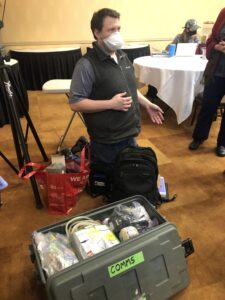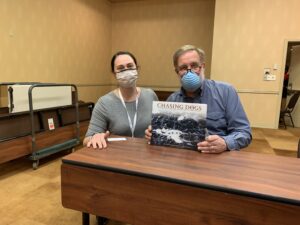It is impossible to make the Iditarod a reality without the volunteers. This race is spread across 1,000 miles of Alaskan wilderness, takes between 8 and 15 days, and requires nearly 2,000 people to support human mushers and their canine athletes. The sheer number of people involved in making this happen is simply astounding, and the work these people do to support the event is remarkable. There is a job for everyone. Want to be inside and have an organizational task? Welcome to registration! Want to support the logistics and be part of the action? How about parking or security?

TOTT Finalist Cindy Emmons gets tips from Carl on how to dog-handle at the start!
Ready to get right in there with the mushers and dogs? Take the dog-handler class and help out at the Ceremonial Start or Willow Restart! Involved in IT and communications? COMMs is for you. Take your snowmachine and be a trailbreaker (laying out more than 15,000 markers). Veterinarians from across the country are here in Anchorage and spread across the entire trail. Pilots of the Iditarod Air Force will fly more than a thousand miles these next two weeks, transporting dogs and supplies – but also doing the grunt work of collecting trash. Trailsweeps are the eyes and ears on the trail…and the equivalent of the SAG (support and gear) wagon in traditional racing. I could go on and on and on…..the list of jobs and volunteers willing to do these tasks is endless.
Today’s culminating session of the IditarodEDU conference provided the opportunity to hear from some of these volunteers. An Iditarod Air Force pilot admitted they are in it for the love of flying, but have developed a passion for the race and the dogs. He stated, “This is an awesome opportunity to go flying…remote flying to support the race…and the people make us come back. They’re great friends”.

COMMs Coordinator Reece Roberts shares Cripple’s technology box.
Reece Roberts, COMMunications Coordinator shared the tools of the trade and the challenges of transmitting information from remote areas. Official Iditarod photographer Jeff Schultz showed what it takes to get that great shot out on the trail. These are just some of the amazing people who give their time, energy, and support to this race. Hearing their stories, understanding the logistics, and organizing of the army of volunteers working collaboratively to make this event happen was awe-inspiring.

With photographer Jeff Schultz
As remarkable as it was to meet these rock-star Iditarod Volunteers it has been the ordinary people I’ve talked with that has me hopeful for this race to continue another 50 years. This morning my daughter and I chatted with another mother-daughter duo who live here in Alaska. They are volunteering tomorrow morning in parking, getting up at 3am to make it to Anchorage, in order to stand in the cold, keeping mushers and their vehicles safe. Today at dog-handling training I stood next to volunteers from Massachusetts, New Hampshire, North Carolina, and Tennessee. Yesterday, I spoke with a woman from South Carolina who is volunteering to do dog urine collection! It is important to realize that while the Iditarod is culturally and historically relevant to Alaska, it has significant pull on people across the globe. Those people are willing to spend time, energy, and money to help out at this event. If anyone deserves to be lauded and appreciated it is the thousands of volunteers.
Teachers: Discuss with your class the variety of volunteer options available at the Iditarod. You can vote on which volunteer job each student would like to try and create a bar graph of the results. What are some of the requirements for certain positions – such as vets or pilots? Answer the question “Why do you think people volunteer to help at the Iditarod?” Research ways you can volunteer in your local community.


